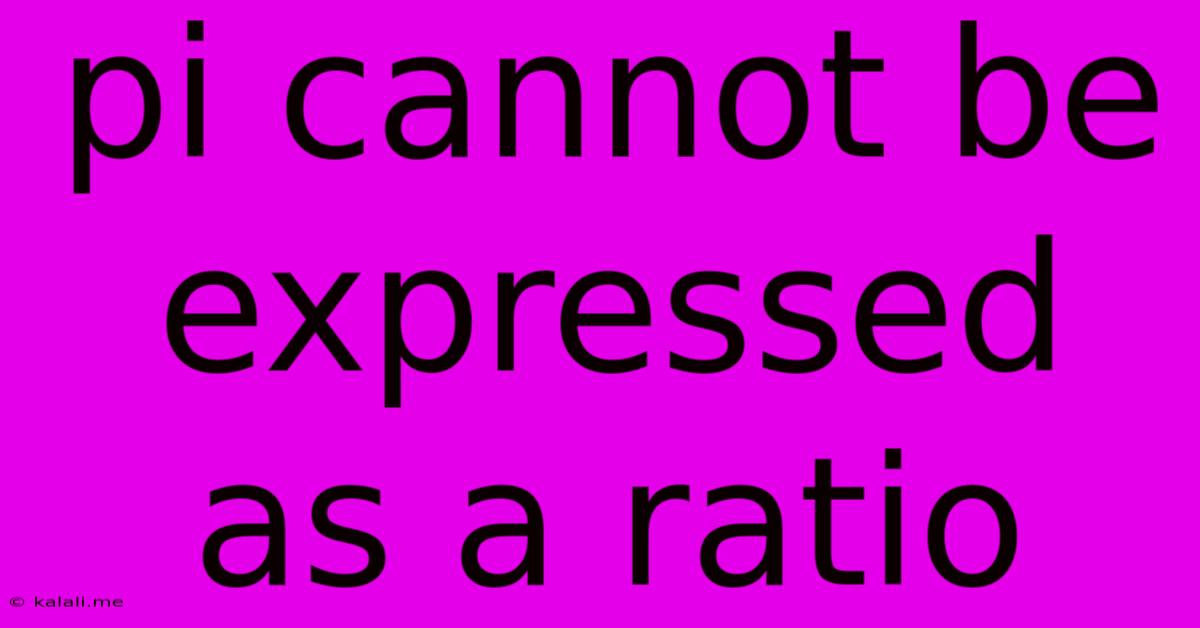Pi Cannot Be Expressed As A Ratio
Kalali
Jun 07, 2025 · 3 min read

Table of Contents
Pi: The Irrational Number That Defines a Circle
Pi (π), approximately 3.14159, is a mathematical constant representing the ratio of a circle's circumference to its diameter. It's a number so fundamental to geometry and mathematics that it appears in countless formulas and equations. But what makes pi truly unique is its irrationality – it cannot be expressed as a simple fraction of two whole numbers. This seemingly simple fact has profound implications for our understanding of mathematics and the nature of numbers. This article will delve into why pi is irrational, exploring the historical attempts to pin down its value and the implications of its irrational nature.
Understanding Rational and Irrational Numbers
Before diving into the specifics of pi, let's clarify the difference between rational and irrational numbers. A rational number can be expressed as a fraction a/b, where 'a' and 'b' are integers (whole numbers), and 'b' is not zero. Examples include 1/2, 3/4, and even whole numbers like 5 (which can be written as 5/1).
An irrational number, on the other hand, cannot be expressed as such a fraction. Their decimal representation goes on forever without repeating. Famous examples, besides pi, include the square root of 2 (√2) and Euler's number (e).
The Proof of Pi's Irrationality: A Glimpse into the Complexities
Proving that pi is irrational isn't a simple task. The most common proofs involve advanced calculus and techniques beyond the scope of this article. However, the core idea involves demonstrating that if pi were rational, it would lead to a contradiction. These proofs often involve techniques like proof by contradiction, showing that assuming pi is rational leads to an impossible outcome. The intricacies involve manipulating infinite series and demonstrating inconsistencies within the assumed fractional representation. The elegance and complexity of these proofs highlight the deep mathematical nature of this seemingly simple constant.
The Historical Pursuit of Pi: From Ancient Civilizations to Modern Computation
Humans have been fascinated by pi for millennia. Ancient civilizations, like the Babylonians and Egyptians, developed approximations of pi through practical measurements. Archimedes, a renowned Greek mathematician, used polygons inscribed and circumscribed around a circle to refine the approximation of pi, paving the way for more precise calculations.
Over the centuries, mathematicians continuously refined the calculation of pi, using increasingly sophisticated methods. With the advent of computers, the calculation of pi has reached trillions of digits, yet the decimal representation continues without any discernible pattern or repetition, further solidifying its irrationality.
The Significance of Pi's Irrationality
The irrationality of pi has significant implications. It highlights the limitations of using simple fractions to represent all numbers. It underscores the richness and complexity of the number system, revealing the existence of numbers that defy simple rational representation. Moreover, pi's irrationality is intrinsically linked to the inherent nature of circles and their relationship to straight lines, a fundamental concept in geometry.
Conclusion: Pi – A Constant Mystery
Pi's irrationality isn't just a mathematical curiosity; it's a testament to the fascinating and often counter-intuitive nature of mathematics. While we can approximate pi to an incredible degree of accuracy, we will never be able to express it exactly as a ratio of two whole numbers. This inherent characteristic contributes to pi's enduring mystery and its central role in mathematics and beyond. The ongoing pursuit of understanding pi continues to push the boundaries of mathematical exploration.
Latest Posts
Latest Posts
-
Breaking Surface Tension Before Hitting Water
Jun 08, 2025
-
Do Baptist Believe In Speaking In Tongues
Jun 08, 2025
-
Hunting Cap Catcher In The Rye
Jun 08, 2025
-
Can You Bake In Aluminum Pans
Jun 08, 2025
-
Substitute For Instant Mashed Potato Flakes
Jun 08, 2025
Related Post
Thank you for visiting our website which covers about Pi Cannot Be Expressed As A Ratio . We hope the information provided has been useful to you. Feel free to contact us if you have any questions or need further assistance. See you next time and don't miss to bookmark.